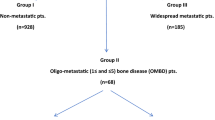Abstract
Background and Objectives
The effect of follow-up after primary treatment for breast cancer on overall survival remains highly questionable, and controversy still exists regarding the benefits of regular follow-up. We therefore attempted to assess the role of intensive follow-up in patients with bone metastases.
Methods
We analyzed the survival of 87 breast cancer patients who relapsed first in bone diagnosed either with or without symptoms, from 1985 to 1998. Overall survival (OS) was the main outcome. Recurrence was coded as either asymptomatic, elevated tumor marker, or symptomatic.
Results
The median disease free interval was 33 months in the asymptomatic group, 42 months in the elevated tumor marker group, and 43 months in the symptomatic group. Overall survival did not differ significantly between the groups. The median OS was 77 months in the asymptomatic group, 78 months in the elevated tumor marker group, and 79 months in the symptomatic group.
Conclusions
Our study showed that intensive testing, including assessment of serum tumor markers and bone scans, did not improve OS. The results of our study supported the American Society of Clinical Oncology (ASCO) recommendations that routine use of bone scans is not recommended.
Similar content being viewed by others
References
Jager W: The early detection of disseminated (metastasized) breast cancer by serial tumour marker measurements.EurJ Cancer Prev 2:133–139, 1993.
McQuellon RP, Muss HB, Hoffmann SL, Russell G, Craven B, Yellen SB: Patient preference for treatment of metastatic breast cancer: A study of women with early-stage breast cancer.J Clin Oncol 13:858–868, 1995.
The GIVIO Investigators: Impact of follow-up testing on survival and health-related quality of life in breast cancer patients. A multicenter randomized controlled trial.JAMA 271:1587–1592, 1994.
Holli K, Hakama M: Effectiveness of routine and spontaneous follow-up visits for breast cancer.Eur J Cancer Clin Oncol 25:251–254, 1989.
Rutgers EJ, van Slooten EA, Kluck HM: Follow-up after treatment of primary breast cancer.Br J Surg 76:187–190, 1989.
Temple LK, Wang EE, McLeod RS: Preventive health care, 1999 update: 3. Follow-up after breast cancer. Canadian Task Force on Preventive Health Care.CMAJ 161:1001–1008, 1999.
2000 Update of Recommendations for the Use of Tumor Markers in Breast and Colorectal Cancer: Clinical Practice Guidelines of the American Society of Clinical Oncology.J Clin Oncol 19:1865–1878, 2001.
Chan DW, Beveridge RA, Muss H, Fritsche HA, Hortobagyi G, Theriault R, Kiang D, Kennedy BJ, Evelegh M: Use of Truquant BR Radioimmunoassay for Early Detection of Breast Cancer Recurrence in Patients With Stage II and Stage III Disease.J Clin Oncol 15:2322–2328, 1997.
Holmes FA, Buzdar AU, Kau SW,et al: Combinedmodality approach for patients with isolated recurrence of breast cancer (IV-NED): The M.D. Anderson experience.Breast Disease 7:7–20, 1994.
Nieto Y, Nawaz S, Jones RB, Shapall EJ, Cagnoni PJ, McSweeney PA, Baron A, Razook C, Matthes S, Bearman SI: Prognostic model for relapse after highdose chemotherapy with autologous stem-cell transplantation for stage IV oligometastatic breast cancer.J Clin Oncol 20:707–718, 2002.
Hortobagyi GN: Can We Cure Limited Metastatic Breast Cancer?J Clin Oncol 20:620–623, 2002.
te Boekhorst DS, Peer NG, van der Sluis RF, Wobbes T, Ruers TJ: Periodic follow-up after breast cancer and the effect on survival.EurJ Surg 167:490–496, 2001.
Coleman RE, Rubens RD: The clinical course of bone metastases from breast cancer.Br J Cancer 55:61–66, 1987.
Galasko, CSB: The anatomy and pathways of skeletal metastases. In: Weiss L and Gilbert HA eds, Bone Metastasis, p49, G.K. Hall, Boston.
Sobin LH, Wittekind Ch eds: TNM classification of Malignant Tumours, 5th ed, New York, Wiley-Liss, 1997.
Narita T, Funahashi H, Kontani K, Kanngai R: NCC-ST-439.Drugs of the Future 19:1084–1087, 1994.
Crippa F, Bombardieri E, Seregni E, Castellani MR, Gasparini M, Maffioli L, Pizzichetta M, Buraggi GL: Single determination of CA 15.3 and bone scintigraphy in the diagnosis of skeletal metastases of breast cancer.J Nucl Biol Med 36:52–55, 1992.
Joseph E, Hyacinthe M, Lyman GH, Busch C, Demps L, Reintgen DS, Cox CE: Evaluation of an Intensive Strategy for Follow-up and Surveillance of Primary Breast Cancer.Ann Surg Oncol 5:522–528, 1998.
Del Turco MR, Palli D, Carddi A, Ciatto S, Pacini P, Ditante V: Intensive Diagnostic Follow-up After Treatment of Primary Breast Cancer-A Randomized Trial.JAMA 271:1593–1597, 1994.
Greenberg PA, Hortobagyi GN, Smith TL, Ziegler LD, Frye DK, Buzdar AU: Long-term follow-up of patients with CR following combination chemotherapy for metastatic breast cancer.J Clin Oncol 14:2197–2205, 1996.
Hortobagyi GN, Theriault RL, Lipton A, Porter L, Blayney D, Sinoff C, Wheeler H, Simeone JF, Seaman JJ, Knight RD, Heffernan M, Mellars K, Reitsma DJ: Long-term prevention of skeletal complications of metastatic breast cancer with Pamidronate. Protocol 19 Aredia Breast Cancer Study Group.J Clin Oncol 16:2038–2044, 1998.
Tu SM, Millikan RE, Mengistu B, Delpassand ES, Amato RJ, Pagliaro LC, Daliani D, Papandreou CN, Smith TL, Kim J, Podoloff DA, Logothetis CJ: Bonetargeted therapy for advanced androgen-independent carcinoma of the prostate: a randomized phase II trial.Lancet 357:336–341, 2001.
Recommended breast cancer surveillance guidelines. American Society of Clinical Oncology.J Clin Oncol 15:2149–2156, 1997.
Smith TJ, Davidson NE, Schapira DV, Grunfeld E, Muss HB, Vogel VG 3rd, Somerfield MR: American Society of Clinical Oncology 1998 Updated of Recommended Breast Cancer Surveillance Guidelines.J Clin Oncol 17:1080–1082, 1999.
Author information
Authors and Affiliations
About this article
Cite this article
Sato, N., Hino, M. & Sano, M. Detection of bone metastases in routine follow-up after treatment for primary breast cancer. Breast Cancer 10, 335–340 (2003). https://doi.org/10.1007/BF02967654
Received:
Accepted:
Issue Date:
DOI: https://doi.org/10.1007/BF02967654




